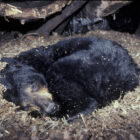Why do lemmings commit mass suicide?

The concept of lemmings committing mass suicide is one of the more pervasive animal myths. Contrary to popular belief, lemmings do not intentionally commit mass suicide. The notion of these small, furry rodents voluntarily plunging off cliffs or into bodies of water en masse is a misinterpretation rooted in historical misconceptions and popular culture rather than factual behavior.
Population boom
Lemmings are small rodents found in the Arctic and neighboring regions. They are known for their cyclical population fluctuations, where their numbers can significantly increase and then decline. During population booms, lemmings may migrate in large numbers, often in search of new habitats or resources. This migration can lead them to cross bodies of water or encounter obstacles like cliffs, which, due to their poor vision, may result in accidental falls.
Origin of the myth
The myth of lemmings intentionally committing suicide gained traction from a Disney documentary called “White Wilderness” in 1958. The film showed staged footage of lemmings supposedly committing mass suicide by jumping off cliffs. However, it was later revealed that the scenes were staged by the filmmakers who herded the lemmings and forced them off the cliff to create the narrative. This sensationalized and falsified depiction perpetuated the myth of lemming suicides and embedded it in popular culture.
In reality, lemmings do not engage in suicidal behavior. They are driven by their natural instincts for migration and population dynamics, which can lead to accidental deaths during these movements due to obstacles in their path, such as bodies of water or steep terrain. These instances of accidental deaths in the context of migration were misinterpreted as intentional suicide.
High and low population cycles
The cyclical fluctuations in lemming populations are primarily driven by a combination of factors, including predation, competition for resources, disease, and the availability of food. These cycles of high and low population numbers are a natural part of their ecosystem dynamics rather than intentional acts of mass self-destruction.
The behavior and myths surrounding lemming suicides serve as a cautionary tale, highlighting the importance of critically examining and verifying information before accepting it as fact.
The myth perpetuated by misinterpretation, sensationalized media, and staged events rather than actual behaviors exhibited by these small rodents. Lemmings undergo natural population fluctuations and migrations that, due to their poor vision and environmental obstacles, can lead to accidental deaths but not intentional mass self-destruction. Understanding and dispelling such myths are crucial to appreciating and accurately portraying the natural world.










